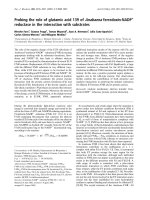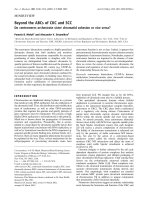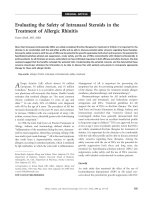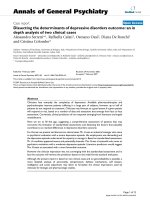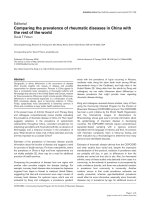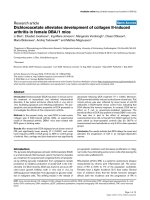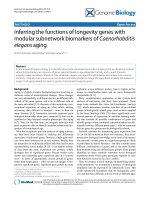Báo cáo y học: " ALGOS: the development of a randomized controlled trial testing a case management algorithm designed to reduce suicide risk among suicide attempters" potx
Bạn đang xem bản rút gọn của tài liệu. Xem và tải ngay bản đầy đủ của tài liệu tại đây (585.99 KB, 7 trang )
STUDY PROT O C O L Open Access
ALGOS: the development of a randomized
controlled trial testing a case management
algorithm designed to reduce suicide risk among
suicide attempters
Guillaume Vaiva
1,2*
, Michel Walter
3
, Abeer S Al Arab
2
, Philippe Courtet
4
, Frank Bellivier
5
, Anne Laure Demarty
2
,
Stephane Duhem
2
, Francois Ducrocq
6
, Patrick Goldstein
6
, Christian Libersa
2
Abstract
Background: Suicide attempts (SA) constitute a serious clinical problem. People who attempt suicide are at high
risk of further repetition. However, no interventions have been shown to be effective in reducing repetition in this
group of patients.
Methods/Design: Multicentre randomized controlled trial.
We exa mine the effectiveness of «ALGOS algorithm»: an intervention based in a decisional tree of contact type
which aims at reducing the incidence of repeated suicide attempt during 6 months. This algorithm of case
management comprises the two strategies of intervention that showed a significant reduction in the number of
SA repeaters: systematic telephone contact (ineffective in first-attempters) and «Crisis card» (effective only in first-
attempters). Participants who are lost from contact and those refusing healthcare, can then benefit from «short
letters» or «postcards».
Discussion: ALGOS algorithm is easily reproducible and inexpensive intervention that will supply the guidelines for
assessment and management of a population sometimes in difficulties with healthcare compliance. Furthermore, it
will target some of these subgroups of patients by providing specific interventions for opt imizing the benefits of
case management strategy.
Trial Registration: The study was registered with the ClinicalTrials.gov Registry; number: NCT01123174.
Background
Suicidal behaviors are multifactorial phenomena. It is
therefore difficult to define only o ne strategy to manage
a suicidal att empt (SA) for the whole population [1]. In
a review of literature of the last 25 years, considering
only randomized controll ed trials (RCT) with suicidal
repetition as primary endpoint, we only find 7 positive
trials out of 24 studies. However, all studies s how an
improvement of compliance to the healthcare plan,
which has led some to say that it doesn’tmatterwhatis
suggested to suicide attempters, as long as they are
offered something [2,3].
The seven positive trials can be divided into t wo cate-
gories: intensive intervention programs (nursing at
home [4], and a series of Brief Psychotherapy Inte rven-
tions (IPB) [5]) and, case management programs.
The strategies of intensive intervention demonstrate
their effectiveness in reducing the number of SA repeti-
tions at short and medium term, but their weakness lies
in the institutional heaviness of deployment and their
expensive financial costs.
The other case managemen t strategies have one com-
mon point: they are dis tinct from classical interventions,
by proposing a “stay in contact” program, which does
not invade the daily life of suicidal attempter, and can
* Correspondence:
1
Département Universitaire de Psychiatrie & Pole de l’Urgence, Lille
University Hospital, Lille, France
Full list of author information is available at the end of the article
Vaiva et al. BMC Psychiatry 2011, 11:1
/>© 2011 Vaiva et al; licensee BioMed Central Ltd. This is an Open Access article distributed under the terms of the Creative Commons
Attribution License ( which permits unrestricted use, distribution, and re production in
any medium, provid ed the original work is properly cited.
be employed in parallel to the eventual healthcare and
offers a reliable and effective treatment in cases of suici-
dal crisis. This kind of case management has inspired
the pioneer Jerome Motto about the neologi sm of “con-
nectedness” [6].
Each one of these strategies is of a great interest in
certain categories of suicide attempters. They differ
fromthefirsttwoonesbyhavingnotonlyalower
financial cost but also an easier set up for the entire
population in a given territory.
In the “SYSCALL” study, 605 suicidal patients dis-
charged directly from Emergency Departments (ED)
were included [7]. A specially trained psychologist con-
tacted patients by telephone, one or three months after
the SA. The aim of this psychological supportive inter-
vention was to evaluate the success of the treatment
plan defined during the ED stay and eventually adjust it.
Over the 13 months follow-up, there were 150 partici-
pants who reattempted suicide, 48 of them before the
one month’ telephone contact. Considering only
the subjects effectively contacted (per protocol analysis),
the telephone contact at one month proved to be very
effective, by reducing to about the half the number of
suicidal reattempts over o ne year (12% versus 21.6% in
the control group). The post-hoc analysis showed no
effect of the contact in first-attempters. The propo sal of
telephone contact was very well accepted and positively
perceived by t he population of this study. In addit ion,
no major side effects were reported by the participants
[8].
Thestrategybasedonthedeliveryofa“crisis card”
was proposed by the English team of Bristol and was
especially interesting for first-attempters. In addition to
usual treatment, t he intervention gr oup was offered a
“resource card” with the telephone number of a junior
doctor in psyc hiatry available 24 hours a day. The inter-
vention had a significant effect on the rate o f SA repeti-
tion at 6 months in the first attempters subgroup only,
compared to a control group (odds ratio 0.64, 95% CI
0.34-1.26) [9]. The beneficial effect observed at 6
months was not maintained at one year [10].
Jerome Motto proposed the strategy of sending letters
to maintain contact with patients at high risk of suicide,
who refused to remain in the healthcare system. Patients
were contacted by short letters, sent by a person who
met them during their hospital stay. The letters were
personalized whenever possible. A self-addressed,
unstamped envelope was always enclosed. These letters
were sent monthly for four months, then every two
months for eight months, and finally every three months
for f our years (24 letters in total). The objective was to
make the patient realize that there is a person con-
cerned about him (its existence), and who maintains
positive feelings towards him, hence the neologism of
“connectedness” proposed by the author. This study
included 3.005 patients admitted to hospital for a depres-
sion or a suicidal crisis in San Francisco from 1969 to
1974. Thirty da ys after hospital discha rge, subjects were
questioned by telephone about adherence to the defined
therapy plan; non-compliant subjects were then rando-
mized into two parallel groups with (N = 389) or without
sending letters (N = 454). The primary endpoint of the
study was to evaluate the impact on suicide rate. This
study showed contrasted results at 5 and 15 years.
Patients in the contact group had a lower suicide rate at
five years (15/389 vs 21/454). Formal survival analyses
revealed a significantly lower rate in the contact group
(p = .04) for the first two years; differences in the rates
gradually dim inished, and by year 14 no differences
between groups were observed (25/389 vs 26/454) [11].
Like Motto’s intervention, an Australian study tested
the effectiveness of a programmed systemati c sending of
a postcard (postcards from the EDge project) during the
year following the SA [12]. The intervention consisted
of a postcard sent to participants in a sealed envelope at
1, 2, 3, 4, 6, 8, 10, and 12 months after discharge
(a total of 8 postcards). The message was the same for
all postcards: «It has been a short time sin ce you were
here at the hospital, and we hope things are going well
for you if you wish to drop us a note, we would be
happy to hear from you». The evaluation concerned all
deliberate self poisoning patients admitted for few days
in a toxicology unit. The initial follow-up was for 12
mont hs, completed later with a one-year extension [13].
The proportion of SA repeaters in the intervention
groupdidnotdiffersignificantlyfromthatinthecon-
trol group (15.1% vs. 17.3% at one year, 21.2% vs. 22.8%
at two years). However, among SA repeaters there was a
lower number of reattempts in contact group (incidence
risk ratio 0.55 at one year, and 0.49 at two years).
These findings were recently replicated by the New
Zealand team of Beautrais: 327 suicide attempters aged
16 years or older, presenting consecutively to ED were
included [14]. The intervention consisted of sending
four “postcards” to participants at two weeks, 1, 3 and 6
months. Patients allocated to control group did not
receive any postcards. All subjects received a standard
treatment in parallel. The number of SA repeaters was
significantly lower in intervention group (31/153, 20.3%)
than in control group (88/174, 50.6%).
Thus, by taking into consideration the strengths and
limitations of each of these four strategies, we propose
to construct a decisional tree of contact type, a case
management algorithm. This monitoring algo rithm
entitled «ALGOS» is based on the two interventions
that showed a significant reduction in the number of SA
repeaters: systematic telephone contact (ineffective in
first-attempters) and «crisis card» (effective only in
Vaiva et al. BMC Psychiatry 2011, 11:1
/>Page 2 of 7
first-attempters). Participants non contacted during
phone call periods and those refusing proposed health-
care, can then benefit from the «short letters» of Motto
or the «postcards» of Carter.
Aims and Hypothesis
The hypothesis is that deployment of «ALGOS» algo-
rithm following a SA, in parallel to usual treatment; will
contribute to the reduction of suicidal b ehaviours at the
six mont hs follow-up. ALGOS algorithm would be more
a «crisis management plan», rather than a «case man-
agement plan».
The main objective is to evaluate the effectiveness of
the algorithm in reducing the number of SA repeaters
during a six months period, compared to a control group
of suicide attempters benefiting from usual treatment.
Secondary objectives to be studied are:
- Evaluating, according to the method validated by
Beecham in 1992 [15], the medical and economic
impact within the year following the introduction of
ALGOS algorithm
- Evaluating the reduction of other suicidal beha-
viours at 6 months (decrease of the total number of
suicide re-attempts in each group, evolution of
Beck’s suicidal ideation score, etc )
- Assessing the maintenance of the algorithm is
effectiveness on suicidal behaviour at 13 months
- Evaluating the differences in the delay of SA repe-
tition within the two groups during the deployment
of the algorithm at 6 months and 13 months
- Finally, a more qualitative assessment may propose
different responding profiles according to the
psychopathology spotted by MINI, the character of
being first-attempters or not, sex, etc
Methods/Design
It is a multicentre, prospective, comparative, single-
blind, randomized controlled trial (ClinicalTrials.gov;
number: NCT01123174). It was authorized by AFSSAPS
(French Health Ministry) and a pproved by the North-
west IV Ethical Committee for the Protection of
Persons.
Setting
23 national centres employing psychiatrists and emer-
gency physicians, who are strongly implicated in the
treatment of suicidal patients and benefiting from a
close collaboration, participate in this program: CHU
Angers, CHU Brest, CHU Caen, CHU Clermont Fer-
rand, CHU Créteil Henri Mondor, CHU Lille, CHU
Marse ille, CHU Montpellier, CHU Nancy, CHU Nantes,
CHU Nice, CHU Paris HEGP, CHU Rennes, CHU Tou-
louse, CH Boulogne, CH Douai, CH Dunkerque,
Polyclinics of Henin Beaumont, CH of Montauban, CH
Quimper, CH Roubaix, CH Tourcoing, CH Vannes.
The deployment of the algorithm is supervised by the
University Hospital of Lille and the evaluations are car-
ried out by the Clinical Investigation Centre (CIC 9301).
The research team has been practising these procedures
of follow-up for more than 10 years (these telephone
contacts), were realized as a pa rt of previous studies,
such as SA patients and road traffic accidents victims.
These telephonic assessments are conducted by specially
trained psychologists using validated landmarks.
Participants
Inclusions can be done during the ED stay or at the dis-
charge from hospital, within 7 days after SA. 900 sub-
jects, men or women aged over 18 years, and s urviving
a SA, whatever the mode of SA is, will be included.
Patients with 4 or more SA during the past three years
(multi repeaters) will not be included.
The participants will give their free, informed, dated
and signed consent.
Randomisation
Once the patient is included, the investigator rando-
mizes him into one of two groups, intervention
(ALGOS) group or control group, using randomization
envelopes. Hence the trial is single-blind, the investiga-
tor knows the allocated group but not the patient.
Randomization done by blocks is centralized at the
CIC of Lille, who follows the inclusions and their distri-
bution in each group. If asymmetrical distribution
appears after an intermediate observation of the first
450 inclusions, it will be possible to make rebalance
between groups, by a person exterior to the study,
according to the number of SA.
Procedure
After verification of inclusion criteria, a physician
informs and answers any questions of the participant in
order to get his «consent for a following contact». The
participant is then randomized an d allocated to ALGOS
group or control group. The physician collects the
following data: socio-demographic characteristics
(including place of birth and place of reside nce), number
of previous SA and headlines of the “care plan defined in
ED” (presence or absence of a companion at hospital dis-
charge, recomm ended psychiatric care, scheduled
appointments, prescription of psychotropic drugs, etc ).
Intervention
For ALGOS patients group
1. Delivery of a «Crisis Card»
All participants surviving a first SA receive a «crisis
car d» with the emergency phone numbers of the cent re
Vaiva et al. BMC Psychiatry 2011, 11:1
/>Page 3 of 7
where t hey are included. This card is inspired from the
proposed “crisis card” of Evans’team: format of a credit
card, green (the colour of hope), plastified, identical for
the whole territory containing the logos of suicide pre-
vention organizations (with websites addresses) and per-
sonalized with the phone number of t he 24 h care
permanence of the concerned centre (see Figure 1) [10].
2. Telephone contact
As regards the ot her patients (not fir st-attempters), a
phone c all is conducted between the 10th and 21st d ay
after the SA. The trained psychologist ensures as possi-
ble the identity of the patient and gets only addressed to
the patient himself. The phone call is done on behalf of
the initial unit where the patient was included. The tele-
phone contact presents a part of a psychological sup-
port, which is based mainly on empathy, reassurance,
expl anation and sug gestion. The aim of this interview is
to verify the adequacy of responses to the existing
healthcare, and otherwise to e ncourage and advise the
patient to make new contacts. Three types of phone
calls are distinguished according to the time of collect-
ing responses [7]:
- Ordinary call (the most common): the treatment
plan is still actual and valid, or the crisis situation
that the participant lived improves. In this case, no
help or advice seems necessary.
- Participant in difficulty or non compliant: the
treatment plan is no longer valid or not followed,
unwillingness exists, or the subject is in psychologi-
cal difficulty: a new treatment plan is eventually sug-
gested, which is already tried during the phone call.
In addition, the concerned contact centre will send
“postcards” during the following five months.
- Identi fic ation of participant at high risk of suicide:
the patient is still victim of intrusive suicidal
thoughts, asking or not for help. The investigator
asks the patient to go to the ED where he was ori-
ginally treated, to be received by a doctor informed
by the concerned contact centre. In case of refusal
by the participant, his general practitioner or the
mobile emergency medical teams “SA MU/Centre
15” are called. The concerned contact centre will
send “postcards” during the following five months.
Telephone contact w ill be abandoned, if unsuccessful
after at least 3 call attempts on 3 different days at 3 dif-
ferent daytimes, and sending “postcards” will be sched-
uled for the next 5 months.
In all cases, a report of the tel ephone calls (or if the
participant is lost of contact, the information that w e
have failed to call him) is sent to the general practi-
tioner and eventually to the psychiatrist treating
patient.
3. Postcard sending
This intervention will consist of a programmed sending
of postcards at M2, M3, M4 & M5 (see Figure 2) to:
• Participants candidate for telephone contact but
not available.
• Participants contacted by telephone but refusing
further care, or non-compliant.
• Participants identified during the phone call as in
difficulty or experiencing suicidal crisis.
These cards are sent in sealed envelopes. They have
identical background (but different form s depending on
the month) for all participants in the study. Further-
more, they are personalized with the name of suicide
attempter, the signature of the physician who included
the patient, and the logo of the hospital where the
patient was originally treated. The cards include the
phone numbers of the care permanence.
In case of the patient wishes to reply (return letter for
the investigator), a new telephone contact will be
attempted.
Écouter
Lire phonétiquement
Control group = process as usual
The participants randomized into the control group do
not benefit from any specific treatment and receive the
usual care, which is in most cases referral back to their
general practitioner (see Figure 3).
Benefits and Risks
We aim at reducin g the number of suicide repeaters in
ALGOS group. The telephone contact at both 6 and
13 mo nths will allow the reorient ation of all the
Figure 1 Example of crisis card. Figure 2 Examples of postcards.
Vaiva et al. BMC Psychiatry 2011, 11:1
/>Page 4 of 7
participants still in difficulty to a suitable healthcare
plan, whatever the treatment group they were in.
The evaluators are well trained to assess suicidal risk.
If a suicidal risk is detected, the participant w ill be
rapidly managed, by the ED which he belon gs to within
a maximum of 24 hours.
A possible risk is the potential psychological impact of
the interventions planned in the algorithm program.
The most invasive procedure of the algorithm (phone
call 15 days after SA) demonstrated its safety and its
good support by the contacted patient [8].
Research for Loss of Contact
In this kind of study, the data may be biased by an exces-
sive number of patients included and lost of contact. To
limit this bias and improve the data quality, the partici-
pants remained lost of contact for the final evaluation,
will be sought for by contacting their general practitioner
as well as by the compilation of active files and records of
ED involved. For participants completely lost of contact,
postal requests will be sent to the mayors of their birth-
place and home town for the status “alive or not”. In case
of notification of death (whatever the r eason), and a fter
the declaration of a serious adverse event, a member of
the research team will question the general practitioner
in order to qualify a suicide or not.
Outcomes
The primary endpoint is the number of participants who
reattempted suicide in each group at 6 months.
The secondary endpoint is the total number of deaths
by suicide in each group at 6 months. The psychopatho-
logical assessment is done through a semi-structured
interview of MINI to observe the presence or absence of
any psychiatric disorder according to DSM IV at
6 months [16]. Suicidal ideation is assessed by Beck’
suicide ideation score in each group at 6 months [17].
The medico-economic assessment is carried out by
the method validated by Beecham & Knapp at 6 months
[15]. The healthcare contacts are also evaluated in order
to compare the cost of ALGOS strategy to those of
potentially prevented suicidal behaviours.
To assess the effect of ALGOS algorithm on the long
term outcome, the same measurements will be realized
at 13 months.
Écout
Sample Size Calculation
The aim of the study is to compare the repetition rate
of SA according to two differen t modes of intervention
at 6 months.
In SYSCALL s tudy, we observed a difference in the
repetition rate of about 10% over 12 months, between
the group contacted at 1 month and the control group.
In the same study, the repetition rate at 6 months was
17.6% in the group with usual treatment and 9.6% i n
the intervention group [7].
If we consider the repetition rate of SA at 6 months as
an endpoint, a rate of 17.6% in group B (CONTROL)
and 9.6% in group A (ALGOS), 409 partic ipants per
group are required for a 90% statistic power. With a
rate of loss of contact estimated to about 10% (i n the
previous study SYSCALL, we observed 9.2% loss of con-
tact), 450 participants per group are to be included.
Lire phonétiquement
Dictionnaire -
Écouter
Lire phonétiquement
Dictionnaire -
1. verbe
1. consider
2. envisage
3. contemplate
4. vision
Statistical method
The following statistical analysis will be performed:
- Control and de scriptive analysis of data: numerical
parameters will be summarized by th eir mean, stan-
dard deviation and median. The frequencies
Figure 3 Study design.
Vaiva et al. BMC Psychiatry 2011, 11:1
/>Page 5 of 7
percentage will be provided with their confidence
interval at 95%.
- Comparisons of means will be realized using
Student test (t test) or analysis of variance for com-
parisons according to several factors. In case of mul-
tiple comparisons, Bonferroni correction will be
applied. Comparisons of frequency percentage will
be performed us ing the Chi square test or e xact
Fischer if necessary.
- Analysi s of predictive factors of SA repetition will
be performed using logistic regressions. An approach
by a decisional tree (CHAID) will also be considered.
- Analysis of time delay of SA repetition will be per-
formed using conventional methods of survival ana-
lysis: Kaplan-Meyer method, log-rank test and Cox
model for multifactorial models.
- The research for specific profiles will be conducted
using clas sification methods to identify clusters with
atypical profiles.
- The concomitant drug treatments, particularly
psychotropic drugs will be taken into consideration
in subsequent analysis to ensure that they do not
induce bias in the results.
Discussion
ALGOS algorithm tries to integrate the limits identified
in controlled trials of “case management” in which the
effectiveness was limited to some specific subgroups of
suicide attempters. Based on the published results in
this field, the aim of ALGOS study is to propose an
algorithm of case management (monitoring) that will
target some of these subgroups of patients by providing
them specific interventions and thus optimizing the ben-
efits of this strategy.
Most of the centres participating in ALGOS study
have skilled expert teams in suicide attempters’ care and
have sometimes developed specific interventions that
differ from one centre to another. This var iability of the
current care in the “control” group will make the effec-
tiveness of ALGOS algorithm more powerful if
demonstrated.
However, while other studies tried to study the effects
of interventions on long-term, the impact of ALGOS
algorithmwillbeevaluatedatshortandmediumterm
(6 and 13 months after SA). If the effectiveness of the
algorithm is observed, future researches will focus on
assessment at longer periods knowing tha t the effect of
these types of intervention seems to fade away with
time.
Finally, the studies showing an effectiveness on redu-
cing SA repetitions of ten employed heavy and expensive
interventions in terms of huma n and financial resources
[4,5]. If the effectiveness of ALGOS algorithm is demon-
strated, this easily reproducible and inexpensive strategy
will allow supplemen tary (or alternative) perspectives to
the usual therapeutic care for a population sometimes in
difficulty with healthcare compliance. In this context, we
will evaluate the medico-economic impact of ALGOS
algorithm and thus its possible generalization in terms
of public health.
Acknowledgements
Funding for this study was provided by a national grant from the French
Health Ministry (PHRC 2009; 313.000€).
We thank psychiatrists and nurses from different inclusion centers for their
extensive practical help throughout the study now and in the future.
Author details
1
Département Universitaire de Psychiatrie & Pole de l’Urgence, Lille
University Hospital, Lille, France.
2
Clinical Investigation Center 9301, INSERM
et CHU Lille, Lille, France.
3
Brest University Hospital & JE 2535, UBO, Brest,
France.
4
INSERM U888, Montpellier University Hospital, Montpellier, France.
5
INSERM U797, Pole de Psychiatrie, CHU de Créteil, Hôpital Henri Mondor &
Paris 12 University, Créteil, France.
6
SAMU 59 et Pôle de l’Urgence, Lille
University Hospital, Lille, France.
Authors’ contributions
All authors were responsible for the development of the study design. GV
and MW have conceived the study. ASaA, PC, FB and FD have been
involved in writing up, revising and optimising the study protocol. FD, MW,
PC and FB coordinated the study in their respective university hospital
center. ALD, SD and the clinical investigation center are responsible for
inclusion of patients in the study and safety monitoring. PG and CL are
involved in the national development of the study and the supervision of
the work. All authors have read and corrected the draft versions and all
authors contributed to and approved the final manuscript.
Competing interests
The authors (GV, ASaA, MW, PC, FB, ALD, SD, FD, PG, CL) declare that they
have no competing interests:
- In the past 5 years, they didn’t received reimbursements, fees, funding, or
salary from an organization that may in any way gain or lose financially from
the publication of this manuscript.
- They doesn’t hold any stocks or shares in an organization that may in any
way gain or lose financially from the publication of this manuscript, either
now or in the future.
- They don’t received reimbursements, fees, funding, or salary from any
organization that holds or has applied for patents relating to the content of
the manuscript.
- They don’t have any other financial or non-financial competing interests.
Received: 18 October 2010 Accepted: 2 January 2011
Published: 2 January 2011
References
1. Reulbach U, Bleich S: Suicide risk after a suicide attempt. BMJ 2008, 337:
a2512.
2. Isacsson G, Rich CL: Management of patients who deliberately harm
themselves. BMJ 2001, 322:213-215.
3. van der Sande R, Buskens E, Allart E, van der Graaf Y, van Engeland H:
Psychosocial intervention following suicide attempt: a systematic review
of treatment interventions. Acta Psychiatr Scand 1997, 96:43-50.
4. Guthrie E, Kapur N, Mackway-Jones K, Chew-Graham C, Moorey J, Mendel E,
Marino-Francis F, Sanderson S, Turpin C, Boddy G, Tomenson B:
Randomised controlled trial of brief psychological intervention after
deliberate self poisoning. BMJ 2001, 323:135-138.
5. Gillieron E: Short psychotherapeutic interventions (four sessions).
Psychother Psychosom 1989, 51:32-37.
6. Motto JA, Bostrom AG: Letter to the Editor. Response to RG Liberman.
Psychiatric Services 2001, 52:1254.
7. Vaiva G, Vaiva G, Ducrocq F, Meyer P, Mathieu D, Philippe A, Libersa C,
Goudemand M: Effect of telephone contact on further suicide attempts
Vaiva et al. BMC Psychiatry 2011, 11:1
/>Page 6 of 7
in patients discharged from an emergency department: randomised
controlled study. Bmj 2006, 332:1241-1245.
8. Gruat G, Cottencin O, Ducrocq F, Duhem S, Vaiva G: Vécu subjectif du
recontact téléphonique après tentative de suicide. 8ème congrés de
L’Encéphale 2010, 36S2:D7-D13.
9. Evans MO, Morgan HG, Hayward A, Gunnell DJ: Crisis telephone
consultation for deliberate self-harm patients: effects on repetition. Br J
Psychiatry 1999, 175:23-27.
10. Evans J, Evans M, Morgan HG, Hayward A, Gunnell D: Crisis card following
self-harm: 12-month follow-up of a randomised controlled trial. Br J
Psychiatry 2005, 187:186-187.
11. Motto JA, Bostrom AG: A randomized controlled trial of postcrisis suicide
prevention. Psychiatr Serv 2001, 52:828-833.
12. Carter GL, Clover K, Whyte IM, Dawson AH, D’Este C: Postcards from the
EDge project: randomised controlled trial of an intervention using
postcards to reduce repetition of hospital treated deliberate self
poisoning. BMJ 2005, 331:805.
13. Carter GL, Clover K, Whyte IM, Dawson AH, D’Este C: Postcards from the
EDge: 24-month outcomes of a randomised controlled trial for hospital-
treated self-poisoning. Br J Psychiatry 2007, 191:548-553.
14. Beautrais AL, Gibb SJ, Faulkner A, Mulder RT: A randomized controlled trial
of a brief intervention to reduce repeat presentations to the emergency
department for suicide attempt. Annals of Emergency Medicine 2008,
51:474.
15. Beecham J, Knapp N: Costing psychiatric interventions. Measuring mental
health needs Royal College of Psychiatrists. London; 1992, 163-183.
16. Sheehan DV, Lecrubier Y, Sheehan KH, Amorim P, Janavs J, Weiller E,
Hergueta T, Baker R, Dunbar GC: The Mini-International Neuropsychiatric
Interview (M.I.N.I.): the development and validation of a structured
diagnostic psychiatric interview for DSM-IV and ICD-10. J Clin Psychiatry
1998, 59(Suppl 20):22-23, quiz 34-57.
17. Beck AT, Kovacs M, Weissman A: Assessment of suicidal intention: the
Scale for Suicide Ideation. J Consult Clin Psychol 1979, 47:343-352.
Pre-publication history
The pre-publication history for this paper can be accessed here:
/>doi:10.1186/1471-244X-11-1
Cite this article as: Vaiva et al.: ALGOS: the development of a
randomized controlled trial testing a case management algorithm
designed to reduce suicide risk among suicide attempters. BMC
Psychiatry 2011 11:1.
Submit your next manuscript to BioMed Central
and take full advantage of:
• Convenient online submission
• Thorough peer review
• No space constraints or color figure charges
• Immediate publication on acceptance
• Inclusion in PubMed, CAS, Scopus and Google Scholar
• Research which is freely available for redistribution
Submit your manuscript at
www.biomedcentral.com/submit
Vaiva et al. BMC Psychiatry 2011, 11:1
/>Page 7 of 7


